Abstract
The relative contributions of the various lymphoid tissue compartments (follicle centre, mantle zone, extrafollicular area, and reticular epithelium) of clinically normal nasopharyngeal (adenoid) and palatine tonsils of young children (mean age 5, range 2–10 years) were found to be almost identical in the two organs. In adenoid hypertrophy and recurrent palatine tonsillitis a significant relative reduction of the contributions of follicle centres and mantle zones occurred along with an increase of the extrafollicular compartment. The tonsillar Ig-producing cell systems in health and disease were studied by paired immunohistochemical staining. Only occasional IgE-producing cells were seen in normal as well as in diseased specimens. A general predominance of IgG cells followed by the IgA, IgM and IgD classes was demonstrated in both organs. In the palatine tonsils the percentage class ratios (64·4:29·6:4·3:1·7) were virtually unaltered in disease. Conversely, the class ratios were changed from 54·2:35·2:7·4:3·3 in healthy adenoids to 70·3:23·3:4·7:1·7 in hypertrophy. Intensified B-cell stimulation associated with disease was indicated as the follicle centres tended to show an increased density of Ig-producing cells—at least in the palatine tonsils—and, moreover, showed a significant shift to IgG expression. Taking the histomorphometric data into account, a decreased number of extrafollicular Ig-producing cells per tissue unit was indicated in recurrent tonsillitis. This change was most likely secondary to the disease. Conversely, the hypertrophic adenoids showed significantly increased B-cell activity in the extrafollicular compartment—a raised number of IgG-producing cells being especially marked. A difference between the two organs in the response pattern of the Ig-producing cells, especially in the reticular epithelium, might be influenced by a contribution of the secretory immune system to the surface protection of the adenoids.
Full text
PDF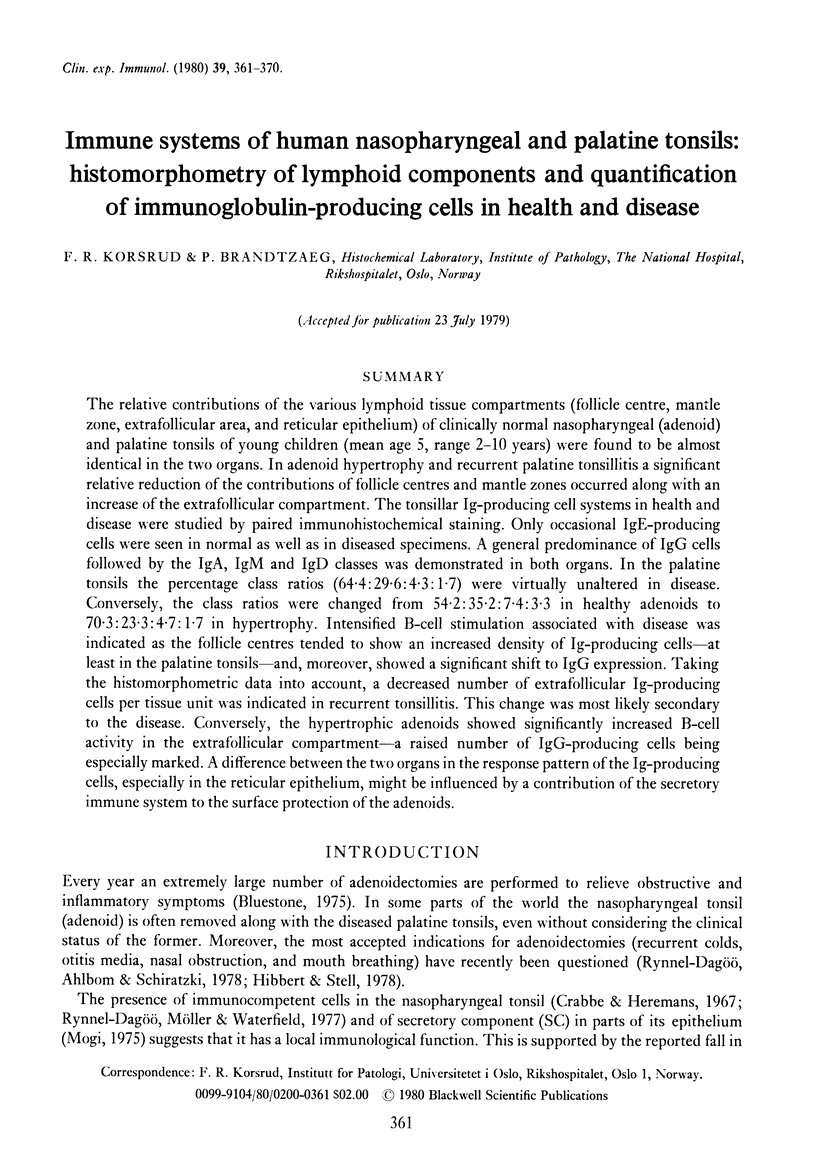

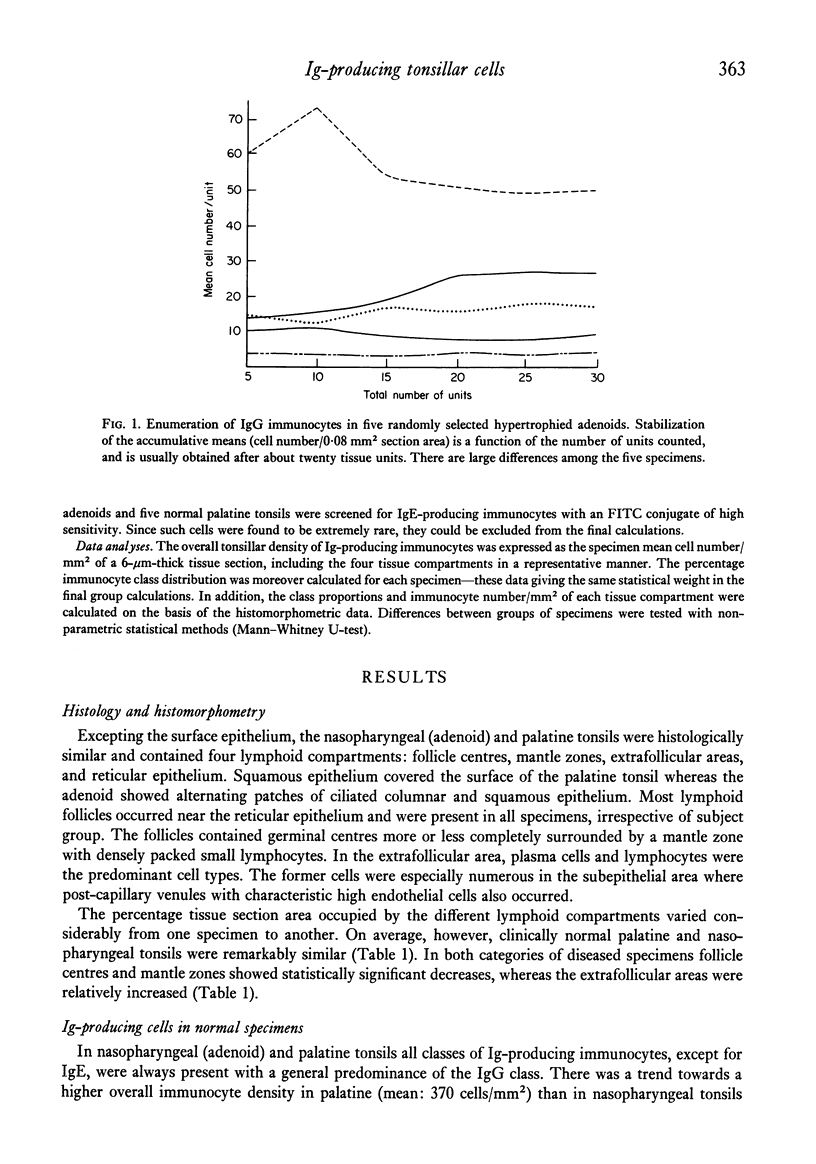

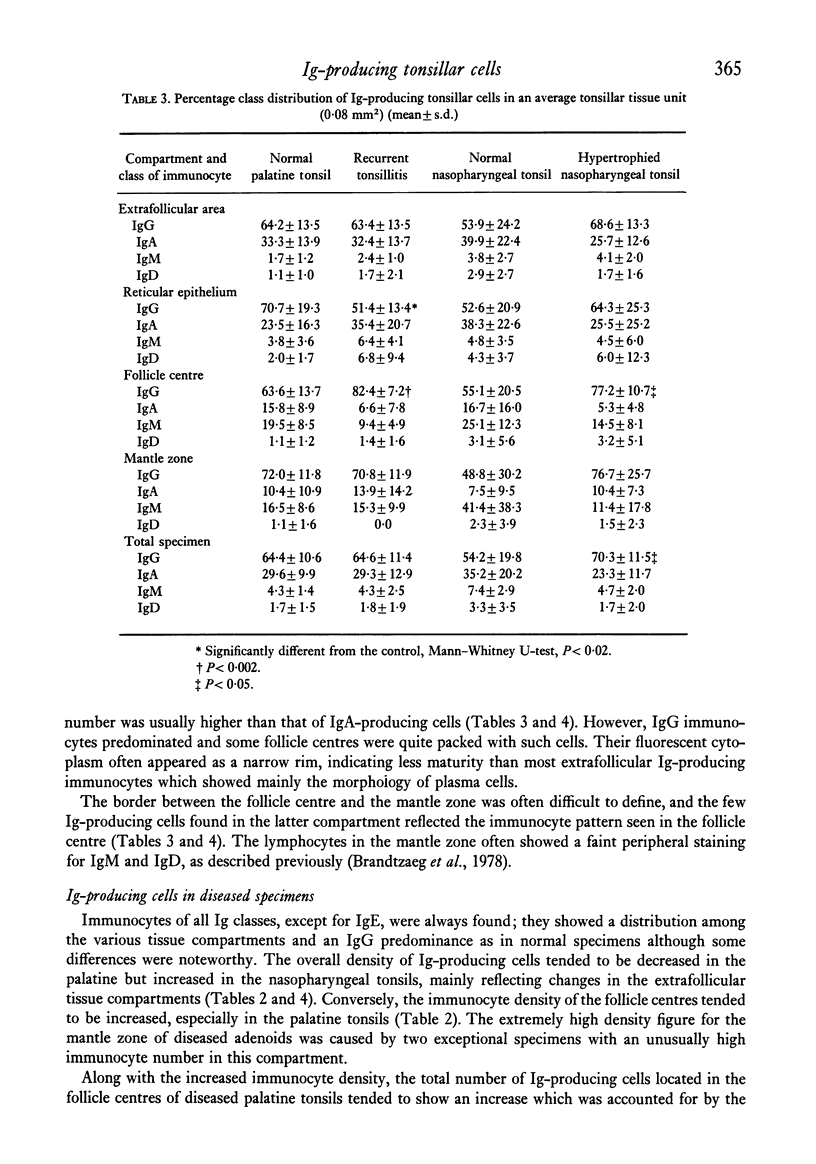

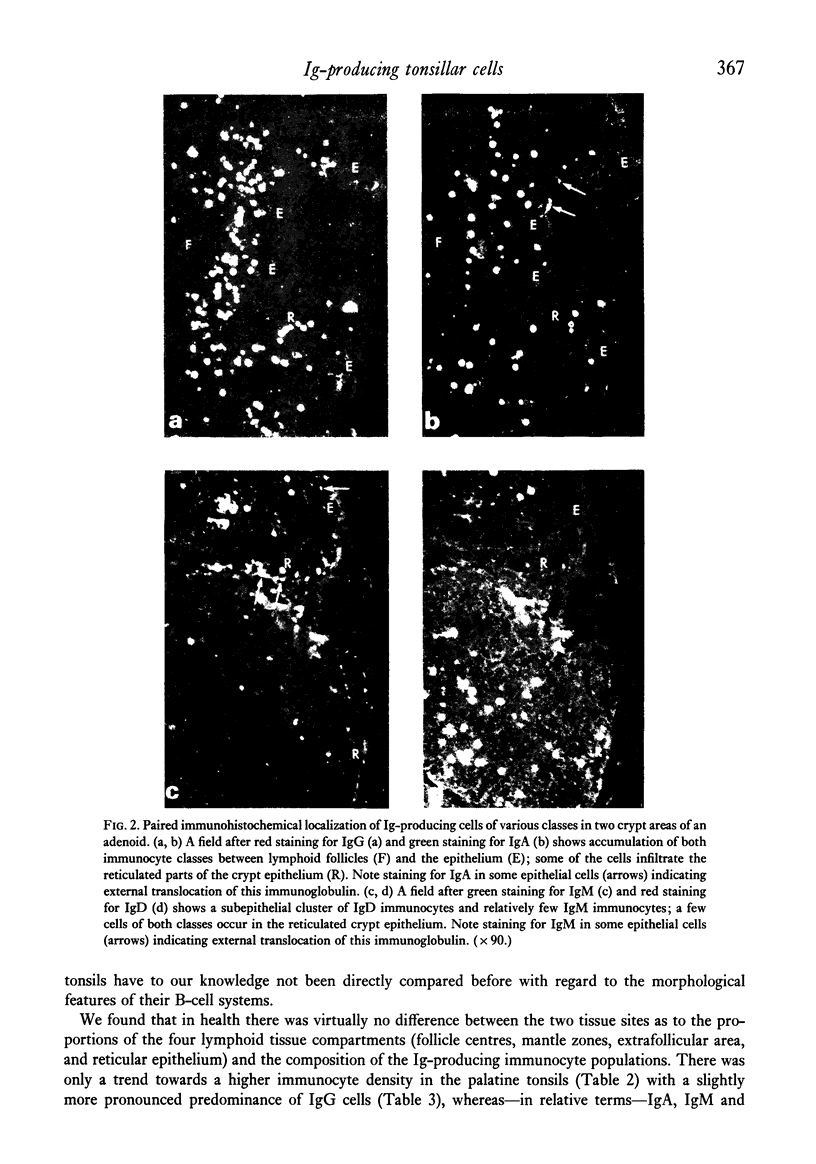

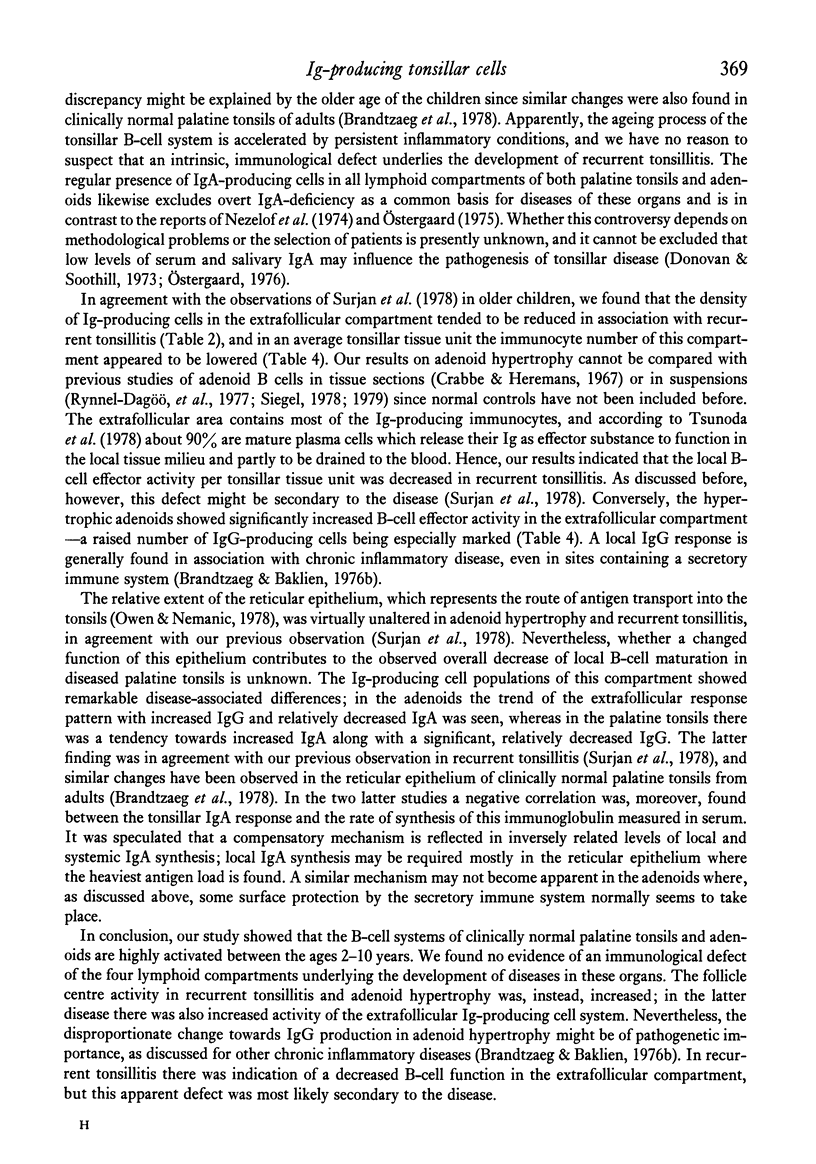

Selected References
These references are in PubMed. This may not be the complete list of references from this article.
- Baklien K., Brandtzaeg P. Comparative mapping of the local distribution of immunoglobulin-containing cells in ulcerative colitis and Crohn's disease of the colon. Clin Exp Immunol. 1975 Nov;22(2):197–209. [PMC free article] [PubMed] [Google Scholar]
- Brandtzaeg P., Baklien K. Inconclusive immunohistochemistry of human IgE in mucosal pathology. Lancet. 1976 Jun 12;1(7972):1297–1298. doi: 10.1016/s0140-6736(76)91767-0. [DOI] [PubMed] [Google Scholar]
- Brandtzaeg P. Conjugates of immunoglobulin G with different fluorochromes. I. Characterization by anionic-exchange chromatography. Scand J Immunol. 1973;2(3):273–290. doi: 10.1111/j.1365-3083.1973.tb02037.x. [DOI] [PubMed] [Google Scholar]
- Brandtzaeg P. Conjugates of immunoglobulin G with different fluorochromes. II. Specific and non-specific binding properties. Scand J Immunol. 1973;2(4):333–348. doi: 10.1111/j.1365-3083.1973.tb02042.x. [DOI] [PubMed] [Google Scholar]
- Brandtzaeg P., Gjeruldsen S. T., Korsrud F., Baklien K., Berdal P., Ek J. The human secretory immune system shows striking heterogeneity with regard to involvement of J chain-positive IgD immunocytes. J Immunol. 1979 Feb;122(2):503–510. [PubMed] [Google Scholar]
- Brandtzaeg P. Mucosal and glandular distribution of immunoglobulin components. Immunohistochemistry with a cold ethanol-fixation technique. Immunology. 1974 Jun;26(6):1101–1114. [PMC free article] [PubMed] [Google Scholar]
- Brandtzaeg P., Surjan L., Jr, Berdal P. Immunoglobulin systems of human tonsils. I. Control subjects of various ages: quantification of Ig-producing cells, tonsillar morphometry and serum Ig concentrations. Clin Exp Immunol. 1978 Mar;31(3):367–381. [PMC free article] [PubMed] [Google Scholar]
- Brandtzaeg P. Two types of IgA immunocytes in man. Nat New Biol. 1973 May 30;243(126):142–143. doi: 10.1038/newbio243142a0. [DOI] [PubMed] [Google Scholar]
- Crabbé P. A., Heremans J. F. Distribution in human nasopharyngeal tonsils of plasma cells containing different types of immunoglobulin polypeptide chains. Lab Invest. 1967 Jan;16(1):112–123. [PubMed] [Google Scholar]
- Donovan R., Soothill J. F. Immunological studies in children undergoing tonsillectomy. Clin Exp Immunol. 1973 Jul;14(3):347–357. [PMC free article] [PubMed] [Google Scholar]
- Hibbert J., Stell P. M. Critical evaluation of adenoidectomy. Lancet. 1978 Mar 4;1(8062):489–490. doi: 10.1016/s0140-6736(78)90146-0. [DOI] [PubMed] [Google Scholar]
- Ho H. C., Kwan H. C., Ng M. H. Immunohistochemistry of local immunoglobulin production in nasopharyngeal carcinoma. Br J Cancer. 1978 Apr;37(4):514–519. doi: 10.1038/bjc.1978.79. [DOI] [PMC free article] [PubMed] [Google Scholar]
- Ishikawa T., Wicher K., Arbesman C. E. Distribution of immunoglobulins in palatine and pharyngeal tonsils. Int Arch Allergy Appl Immunol. 1972;43(6):801–812. doi: 10.1159/000230898. [DOI] [PubMed] [Google Scholar]
- Nezelof C., Diebold N., Meyer B., Vialatte J. Les infections rhino-pharyngées répées de l'enfant: leurs liens avec la production immunoglobulinique locale, étudiée en immunofluorescence. Arch Fr Pediatr. 1974 Nov;31(9):843–859. [PubMed] [Google Scholar]
- Ogra P. L. Effect of tonsillectomy and adenoidectomy on nasopharyngeal antibody response to poliovirus. N Engl J Med. 1971 Jan 14;284(2):59–64. doi: 10.1056/NEJM197101142840201. [DOI] [PubMed] [Google Scholar]
- Ostergaard P. A. IgA levels and carrier rate of Haemophilus influenzae and beta-haemolytic streptococci in children undergoing tonsillectomy. Acta Pathol Microbiol Scand C. 1976 Aug;84(4):290–298. [PubMed] [Google Scholar]
- Rynnel-Dagö B., Ahlbom A., Schiratzki H. Effects of adenoidectomy: a controlled two-year follow-up. Ann Otol Rhinol Laryngol. 1978 Mar-Apr;87(2 Pt 1):272–278. doi: 10.1177/000348947808700223. [DOI] [PubMed] [Google Scholar]
- Rynnel-Dagö B., Möller E., Waterfield E. Characterization of human adenoid cells using surface and functional markers for lymphocyte subpopulations. Clin Exp Immunol. 1977 Mar;27(3):425–431. [PMC free article] [PubMed] [Google Scholar]
- Siegel G. Biochemisch-immunologischer Vergleich lymphoider Zellen aus Rachen- und Gaumenmandeln. Laryngol Rhinol Otol (Stuttg) 1978 Jul;57(7):650–653. [PubMed] [Google Scholar]
- Siegel G. Lymphozytensubpopulationen und Immunoglobulin-konzentrationen in Rachen- und Gaumenmandeln. Laryngol Rhinol Otol (Stuttg) 1979 Jan;58(1):12–14. [PubMed] [Google Scholar]
- Surjan L., Jr, Brandtzaeg P., Berdal P. Immunoglobulin systems of human tonsils. II. Patients with chronic tonsillitis or tonsillar hyperplasia: quantification of Ig-producing cells, tonsillar morphometry and serum Ig concentrations. Clin Exp Immunol. 1978 Mar;31(3):382–390. [PMC free article] [PubMed] [Google Scholar]
- Tada T., Ishizaka K. Distribution of gamma E-forming cells in lymphoid tissues of the human and monkey. J Immunol. 1970 Feb;104(2):377–387. [PubMed] [Google Scholar]
- Tsunoda R., Terashima K., Takahashi K., Kojima M. An ultrastructural study with enzyme-labeled antibody technique on immunoglobulin-containing cells in human tonsils, especially in germinal centers. Acta Pathol Jpn. 1978 Jan;28(1):53–75. doi: 10.1111/j.1440-1827.1978.tb01250.x. [DOI] [PubMed] [Google Scholar]


